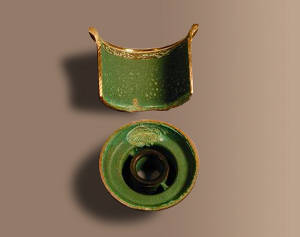Dezincification 3
 Many brasses are subject to dezincification, particularly hot stamping and die-casting brasses. The use of dezincification resistant brass usually solves this corrosion problem. This water meter body failed because the level of impurities was too high and changed the structure of the brass to one susceptible to dealloying. The use of a corrosion test to BS EN ISO 6509 would have demonstrated the unsuitability of this composition in aggressive waters.
Many brasses are subject to dezincification, particularly hot stamping and die-casting brasses. The use of dezincification resistant brass usually solves this corrosion problem. This water meter body failed because the level of impurities was too high and changed the structure of the brass to one susceptible to dealloying. The use of a corrosion test to BS EN ISO 6509 would have demonstrated the unsuitability of this composition in aggressive waters.
Posted on: 21st Aug 2016
Corrosion Fatigue 2
 This pump shaft in nickel-copper alloy K-500 failed by corrosion fatigue. The fatigue started at a pit caused by crevice corrosion in seawater, something that this alloy can be susceptible to. The pit then acted as a stress raiser, which increased local stresses sufficiently to initiate fatigue. This was an expensive failure as significant damage was done to the pump internals when the failure occurred.
This pump shaft in nickel-copper alloy K-500 failed by corrosion fatigue. The fatigue started at a pit caused by crevice corrosion in seawater, something that this alloy can be susceptible to. The pit then acted as a stress raiser, which increased local stresses sufficiently to initiate fatigue. This was an expensive failure as significant damage was done to the pump internals when the failure occurred.
Posted on: 21st June 2016
SCC Of Austenitic Cast Iron
 This is a microsection showing stress corrosion cracking of an austenitic cast iron pump case. This alloy has been used extensively for large, single stage pump cases, but it is susceptible to SCC in warm seawater. Stress relieving can extend the life, but failures generally occur in 1.5 to 5 years, depending on local stresses. The solution to this problem is to use a superduplex stainless steel pump case to ASTM A995 grade 6A, if cast, or to use a fabricated case made from UNS S32760.
This is a microsection showing stress corrosion cracking of an austenitic cast iron pump case. This alloy has been used extensively for large, single stage pump cases, but it is susceptible to SCC in warm seawater. Stress relieving can extend the life, but failures generally occur in 1.5 to 5 years, depending on local stresses. The solution to this problem is to use a superduplex stainless steel pump case to ASTM A995 grade 6A, if cast, or to use a fabricated case made from UNS S32760.
Posted on: 7th July 2016
Availability
During design, it is important to ensure that alloys being specified are readily available. Just because an alloy is listed in standards does not mean that it is currently manufactured. As an example, it was desired to change from copper to a brass for tanks in instant hot water heaters to reduce cost. In hot water dezincification is very likely with a brass, so a 70/30 arsenical brass to British Standard CZ126 or UNS C26100 was selected. Unfortunately, this is only available as pipe and tubing and not as sheet, which was required to make the heater. Copper-nickel was more expensive than copper, so no material change was made.
It is important to check availability before writing specifications to avoid costly delays.
Posted on: 7th June 2016
Procurement
When specifying alloys it is sometimes thought that simply requesting supply to ASTM standards will be adequate. However, there are potential corrosion problems that can arise due to incorrect manufacturing. One example is copper and copper alloy tubing for heat exchangers, which may contain carbon films from the manufacturing process that cause pitting in service. Only BS2871 Part 3 specifies that tubes must be free of “deleterious films” in the bore, although it does not specify a test.
Nickel aluminium bronze can have undesirable phases in it that can be rapidly attacked in seawater. To combat this, it is common to specify that the nickel content should be 0.5% or more than the iron content. In addition a final heat treatment after all hot working and welding operations is recommended to restore the optimum microstructure. Neither of these recommendations is included in ASTM specifications.
Similarly, the ASTM requirements for duplex stainless steels are very basic and it is common to also require a low temperature impact toughness test, a corrosion test to ASTM G48 and a microsection at X500 to ensure the quality is adequate and there will not be a premature failure.
Posted on: 7th Aug 2016

